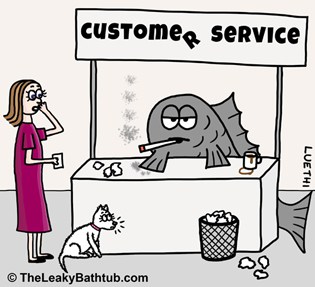
For years I’ve been telling clients that consistently good customer service is a far more powerful marketing (and sales) tool than anything else.
In fact, all the money spent on glossy brochures and slick websites goes down the drain if your customers have a poor purchasing experience… Something I was reminded of recently when I unwittingly bought some stinky, rotten fish at the supermarket.
Here’s what happened (in a nutshell)…
Bought fish. Opened the pack. It stank (even my dog turned its nose up at it). Too stinky to put back in the fridge – it HAD to go in the bin.
Contacted supermarket via Facebook Page… no response for several days. (Marketing lesson: if you’re on social media, you must be ready to respond and provide customer service.)
Emailed supermarket: was told I had to drive across town to return the stinky fish. Spend 45 minutes driving (worth $115 of my billable time) and a few dollars in petrol for a refund of $9.16? I don’t think so!
Was told via email that the supermarket had been notified of the rotten fish they were selling. (But was not told what action had been taken.)
Phoned supermarket to request a refund without chauffeuring rotten fish across town… I was told the store manager had to give approval for this. Eh? Doesn’t the store manager have better things to do than monitor requests for $9.16 refunds?
Bear in mind that my household spends thousands of dollars with this supermarket every year, and we aren’t in the habit of making returns. They can easily track my purchasing habits through my loyalty card number.
Anyhoo, I hadn’t heard back from the store after a few days… the call centre told me that if I wanted an update, I had to call back.
Customer service: fail!
Yet this is a large corporation than spends millions of dollars on TV advertising, direct mail, yadda yadda yadda… it’s New Zealand’s biggest supermarket chain (not a mom ‘n’ pop store).
Mega fail!
I’m sure you’ve had similar experiences a consumer.
Let’s take a look and see how a company can better handle customer complaints…
The key thing is to consider the outcomes a customer wants… But what outcomes does a customer want?
There are two outcomes you should work towards:
1. Fixing the customer’s immediate problem
Fixing the customer’s immediate problem should be relatively simple: apologise sincerely, and make restitution.
The nature of “restitution” may vary depending on the status of that customer. Yes, the restitution should always fully compensate a customer (and in a way that’s convenient to them, seeing as they’ve already been inconvenienced), but if it’s a VIP customer that’s been loyal to you for many years, you may want to go beyond the basics.
For example, with the stinky fish scenario, the ideal outcome would have been for them to quickly agree to the refund, and mail me a voucher. (I would have been happy with a $10 voucher.)
2. Fixing the wider issue
Most people care about the people around us. So with the stinky fish example, I would hate for an elderly person to buy the rotten seafood; not realise it’s rotten; and get really sick.
After all, that’s the real reason I alerted the supermarket – I’m not that fussed about my $9.16, it’s more important to me that other people don’t get sick from eating dodgy food.
Sure, the customer service centre told me that the supermarket had been notified, but that’s not quite enough. Ideally they would have gone into more detail, and told me what corrective action had been taken – e.g. the seafood counter had been examined, and all the fish from that batch had been pulled off the shelves.
The customer service issue isn’t fixed until both the immediate and wider issues are solved
Customers are left with a bad taste in their mouths if the problem isn’t fully solved.
However, many businesses make the mistake of fixing just the customer’s immediate issue… but that isn’t enough to re-establish your business as being high quality and trustworthy.
Speed is the other issue here: customers want both the immediate problem and the wider issue dealt with promptly.
If for any reason you can’t action something right away, let the customer know when you will action it – and do it. And then give them a detailed, timely update when you have rectified the issue. That’ll help restore your business’ credibility and professionalism.
What happens if you don’t put things right in this way?
Not addressing customer problems in a way that satisfies the disgruntled customer is expensive for business.
The White House Office of Consumer Affairs reckons that “news of bad customer services reaches twice as many ears as praise for a good service experience”.
I’d say that it’s more than twice, in this age of social media… depending on how connected (and verbal) someone is, it could easily be 5 or 10 times – or more. (I know for sure that the tale of my stinky fish will reach thousands of people globally!)
What’s even more worrying is that for every customer who bothers to complain, 26 other customers remain silent. (Source: White House Office of Consumer Affairs.)
That makes sense: complaining to a business takes time and effort, so many people put it in the “too hard” basket. So if you get a complaint, take it seriously. It might not be important to you, but if someone’s bothered to tell you something, you need to listen. (Whether you agree or not is up to you, but remember the old adage of “the customer is always right”.)
What if the customer is a jerk?
Let’s face it, not all customers are created equal. If the customer is being unreasonable, and they’re getting you riled up, my advice would be to refund their money, and cut them loose.
A wise friend of mine told me that a small business should budget so that they can afford to walk away from difficult customers, and I think that’s wise. You don’t have to serve everyone, and if someone makes you stressed and unhappy, you don’t need to put up with that. Be prepared to give them their money back, and walk away.
But fortunately those customers are rare. It’s far better to focus on keeping your VIPs happy.
That’s the very best marketing you can do. It’s not always easy, but it will be far more effective in the long run than any expensive marketing campaigns.
Prologue: the happy ending
After a week, the supermarket contacted me by Facebook, asking for my address because the Store Manager was going to visit with a gift card.
Sure enough, the next day a $50 gift card was hand-delivered… I was staggered to say the least! (Bearing in mind that I would have been happy with a $10 voucher mailed to me.)
Bonus lesson: the sooner you act on a complaint, the cheaper it will most likely be for you to resolve.
The Manager also explained in more detail the action they’d taken regarding the rotten fish. So yeah, I’m happy again. I will resume shopping at that supermarket (though I may be buying my seafood from elsewhere…). 😉
Summary
- News of bad customer services reaches at least twice as many ears as praise for a good service experience.
- For every customer who bothers to complain, 26 other customers remain silent.
- If you get a complaint:
- Fix the customer’s immediate issue, and make restitution.
- Fix the wider issue – and let the customer know what you’re doing.
- Deal with complaints promptly, to nip them in the bud. (This may save you further expense down the track.)
- Social media is a double-edged sword: if you’re using social media, ensure that problems and complaints are handled swiftly and professionally.



